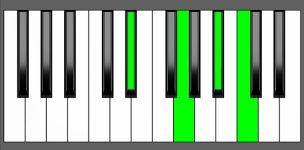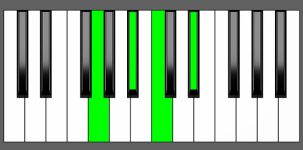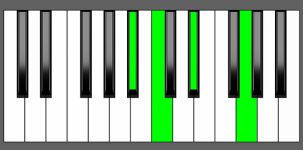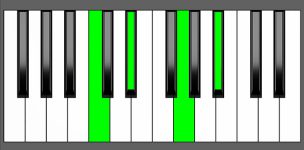Piano Diagram of D#6 in Root Position
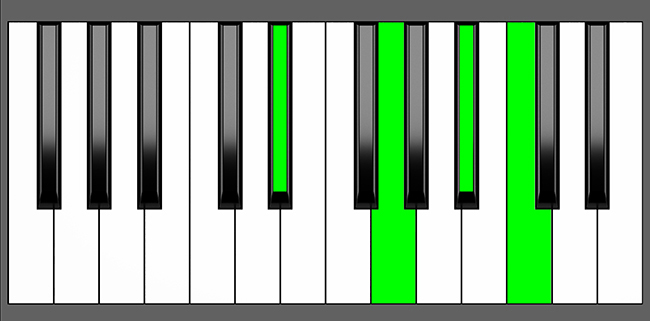
D#6 is a four-note chord consisting of the notes D#, Fx, A#, and B#. It is a major chord with an added sixth. It belongs to the chord family of “added tone chords” (aka “add chord”). Keep reading to gain a deeper understanding of the music theory behind this chord.
Structure of D#6
Notes |
|---|
| D#, Fx, A#, B# |
Intervals |
|---|
| R, 3, 5, 6 |
Finger Position
Left Hand |
|---|
| 5, 3, 2, 1
5, 4, 2, 1 |
Right Hand |
|---|
| 1, 2, 4, 5
1, 2, 3, 4 |
D#6 Chord Inversions
The D#6 chord has a total of 3 inversions:
| Root Position: | D# | Fx | A# | B# |
| 1st Inversion: | Fx | A# | B# | D# |
| 2nd Inversion: | A# | B# | D# | Fx |
| 3rd Inversion: | B# | D# | Fx | A# |
Piano Keyboard Diagrams
Music Theory and Harmony of D#6
Building the D#6 Chord: Different Approaches
Starting from the D# Major Scale
To create a 6th chord, you can use the Major scale as a reference by combining a Root, a 3rd, a 5th, and a 6th.


Apply the formula R, 3, 5, 6 to build a 6th chord:
- Select the Root note, which is D#.
- Pick the 3rd note, which is Fx, and add it to the chord.
- Add the 5th note, which is A#, and include it as well.
- Finally, add the 6th which is B#
by Combining Intervals
To build a 6th chord, one approach is to combine specific intervals, namely a major 3rd, a minor 3rd, and a major 2nd (a whole-tone).
3 + m3 + 2 = 6th chords
For instance, when building a D#6 chord, you can observe that
- D#-Fx forms a major 3rd interval,
- Fx-A# creates a minor 3rd interval, and
- A#-B# makes up a whole-tone interval.
By stacking these intervals together, you can form a D#6 chord.
6th Chords Equivalencies
If we take the third inversion of a 6th chord (which means we move the notes around so that the 6th note becomes the Root note), we end up with a new chord that is equivalent to a min7 chord.
So, if we take the D#6 chord (which has the notes D#, Fx, A#, and B#) and move the notes around so that B# becomes the Root note, we end up with a new chord that is equivalent to a B# min7 chord (which has the notes B#, D#, Fx, and A#).
3rd inversion of D#6 = B# min7 (C min7)
How to Use D#6 in a Chord Progression
Since 6th are based on major triads with an extra sixth, they can substitute the major chords built on the scale of the root. This means that we can use the D#6 chord in those positions on the scale where the harmonization results in a major chord.
This table showcases the harmonized major and natural minor scales where a D# Major chord can be found. In all positions where a D# Maj7 chord is present, the D#6 chord can be used as a variation.
on Major Scales
The D# Maj7 chord appear only in theoretical keys, it’s more practical to refer to its enharmonic equivalent chord Bb Maj7.
| Major Scales | I | ii | iii | IV | V | vi | vii |
|---|---|---|---|---|---|---|---|
| D# = Eb |
Eb Maj7 ⇒ Eb6 = D#6 | F min7 | G min7 | Ab Maj7 | Bb7 | C min7 | Dm7b5 |
| A# = Bb |
Bb Maj7 | C min7 | D min7 | Eb Maj7 ⇒ Eb6 = D#6 | F7 | G min7 | Am7b5 |
- Tonic chord in Eb Major as Eb6
- Subdominant chord in Bb Major as Eb6
on Natural minor Scales
As before, we will refer to Eb6 instead of D#6 because the D# Maj7 chord appear only in theoretical minor keys.
| Minor Scales | i | ii | III | iv | v | VI | VII |
|---|---|---|---|---|---|---|---|
| B# = C | C min7 | Dm7b5 | Eb Maj7 ⇒ Eb6 = D#6 | F min7 | G min7 | Ab Maj7 | Bb7 |
| Fx = G | G min7 | Abxm7b5 | Bb Maj7 | C min7 | D min7 | Eb Maj7 ⇒ Eb6 = D#6 | F7 |
- Mediant chord in C minor as Eb6
- Submediant chord in G minor as Eb6
D#6 in D# Major
D#6 in A# Major
D#6 in B# minor
D#6 in Fx minor
Alternative Names for D#6 Chord
- Re#6
- D# 6th
- D# M6
- D# sixth
- D# add6
- D# Maj6
- D# major6
- D# major 6th
- D# major sixth
- D# major add 6th
